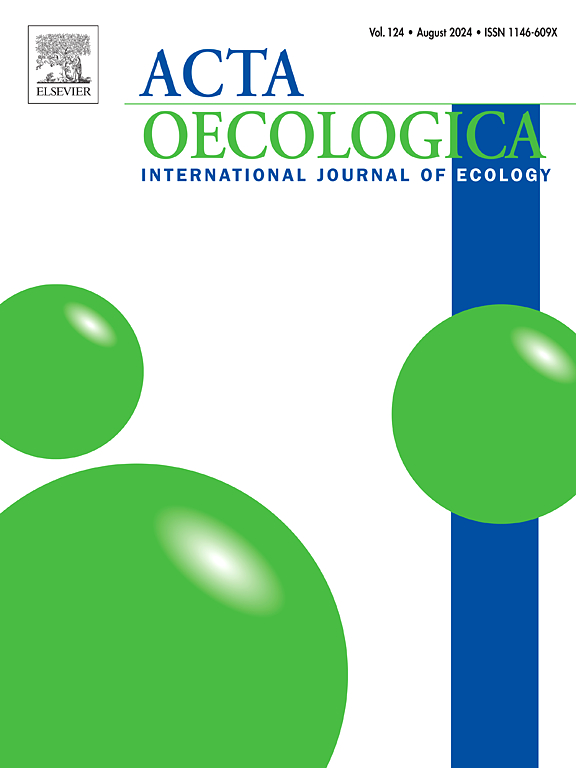Carbon and phosphorus content in soil influences the localized abundance of tree fern Alosphila spinulosa in panchase protected forest area, Nepal
IF 1.3
4区 环境科学与生态学
Q3 ECOLOGY
Acta Oecologica-International Journal of Ecology
Pub Date : 2025-05-14
DOI:10.1016/j.actao.2025.104082
引用次数: 0
Abstract
Tree ferns hold significant ecological and socioeconomic value. In Nepal, they have restricted distribution, occurring in a few patches from eastern to central Nepal. In the localities where they occur, tree ferns are threatened by various anthropogenic pressures. Despite these threats, the influence of environmental variables on the localized distribution and abundance of the species is poorly understood in the country, hindering our ability to devise and implement tailored conservation actions. Our study aimed to investigate the influence of edaphic factors on tree fern abundance in the Panchase Protected Forest Area (PPFA), Central Nepal. This investigation may provide insights into specific factors that can be managed on a fine scale to conserve their populations. We surveyed 43 plots measuring 20 m × 20 m to record the tree fern abundance and collect soil samples. Composite soil samples obtained from the four corners of each plot at a depth of 15 cm were prepared and further analyzed in the laboratory using standard methods for each parameter. An independent sample t-test was applied to assess the difference in site characteristics between tree fern-present and absent sites. Generalized linear regression (Poisson family) was used to examine the fine-scale factors associated with tree fern abundance. Tree fern abundance was found to be correlated with the availability of soil phosphorus and soil carbon. Soil carbon was found to be the most important factor determining the tree fern abundance. A unit increase in percentage soil carbon increases the abundance of tree fern by 47 %, while a unit increase in phosphorus increases the abundance by 1.1 %. Soil pH has a positive influence on the abundance, while nitrogen content has a negative influence, though the relationship was not significant. Our findings emphasize the importance of managing edaphic variables for the conservation of the species.
尼泊尔潘切斯保护区土壤碳磷含量对桫椤局部丰度的影响
蕨类植物具有重要的生态和社会经济价值。在尼泊尔,它们的分布受到限制,只在尼泊尔东部到中部的几个斑块中出现。在它们生长的地方,树蕨受到各种人为压力的威胁。尽管存在这些威胁,但我国对环境变量对该物种的局部分布和丰富程度的影响知之甚少,阻碍了我们制定和实施有针对性的保护行动的能力。本研究旨在探讨尼泊尔中部潘切斯森林保护区(PPFA)土壤因子对蕨类植物丰度的影响。这项调查可能会提供一些具体因素的见解,这些因素可以在很小的范围内进行管理,以保护它们的种群。我们调查了43个面积为20 m × 20 m的样地,记录了蕨类植物的丰度并采集了土壤样品。从每个地块的四个角取15 cm深度的复合土样品制备,并在实验室使用各参数的标准方法进行进一步分析。采用独立样本t检验评估存在和不存在蕨类植物位点特征的差异。采用广义线性回归(泊松族)分析了影响树蕨丰度的精细尺度因子。结果表明,蕨类植物丰度与土壤磷和碳的有效性相关。土壤碳是决定树蕨丰度的最重要因素。土壤碳含量每增加一个单位,树蕨的丰度增加47%,而磷含量每增加一个单位,树蕨的丰度增加1.1%。土壤pH对丰度有正影响,氮含量对丰度有负影响,但关系不显著。我们的研究结果强调了管理土壤变量对物种保护的重要性。
本文章由计算机程序翻译,如有差异,请以英文原文为准。
求助全文
约1分钟内获得全文
求助全文
来源期刊
CiteScore
3.60
自引率
0.00%
发文量
57
审稿时长
>0 weeks
期刊介绍:
Acta Oecologica is venue for the publication of original research articles in ecology. We encourage studies in all areas of ecology, including ecosystem ecology, community ecology, population ecology, conservation ecology and evolutionary ecology. There is no bias with respect to taxon, biome or geographic area. Both theoretical and empirical papers are welcome, but combinations are particularly sought. Priority is given to papers based on explicitly stated hypotheses. Acta Oecologica also accepts review papers.

 求助内容:
求助内容: 应助结果提醒方式:
应助结果提醒方式:


